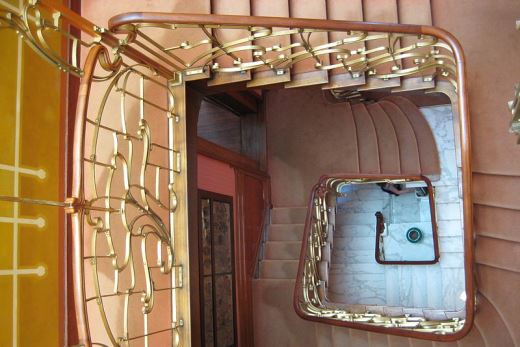Book your transfer
Horta Museum Brussels
Horta Museum: Belgian Art Nouveau and Why It Is Important
Apr 13, 2018 | Travel guide
Compared to other European capitals, Brussels may be a quite smaller city, however that doesn’t stop it from being the center for a number of architectural wonders and heritage sites. As a significant center of Art Nouveau and home to prominent architects who took important roles in creating the ornate style, it would come as no surprise that the capital hosts its fair share of beautiful Art Nouveau buildings. So when you find yourself wandering around the streets of Brussels, keep your eyes open wide for these special architectural gems called the Art Nouveau houses of Brussels, as the most important ones among the architecture types you can expect to find in Brussels. So drop your bags at the hotel once you hop-off your taxi transport and start exploring.
The father of Art Nouveau
Brussels is the Art Nouveau capital of the world, and one man made this the case. A young enthusiast named Victor Horta, tired of the eclectic historical styles his peers kept looking back in the past, established an architectural movement that would define the end of the 19th and beginning of the 20th century. Hand in hand with compatriots Paul Hankar and Paul Saintenoy, Belgium’s most famous architect has left many treasures scattered throughout the heart of Europe, including four townhouses today listed as UNESCO World Heritage Sites.
Having in mind that he had designed some of the country’s most iconic buildings, his former family home is today transformed into the Horta Museum. The Horta Museum is truly a work of “human creative genius, representing the highest expression of the influential Art Nouveau style in art and architecture” as UNESCO described it. Being the most important legacy he ever left, it is a must-visit that is sure to impress all who enter, whether an Art Nouveau aficionado or simply an amateur.
The Horta Museum – Brussels’ most precious gem
By stepping into the Horta Museum, you can truly go back in time, surrounded by all the Art Nouveau accoutrements to accompany the architectural beauty individuals can often only admire from the outside. Built between 1889 and 1901, the Horta Museum was the family home and Horta’s workshop for nearly 20 years. When he finally moved on from the Art Nouveau style for which he, and the museum, are so famous for, Horta sold the house as two separate residences. In 1961, the local authority acquired the property and began the painstaking process of restoration, returning it to its original state in 2013.
Together with three of Horta’s other townhouses in Brussels, this house was recognized as a UNESCO World Heritage site in 2001. It later won the Belgian Museum Prize in 2012 and the European Prize for Cultural Heritage in 2014. With such an impressive list of awards and acknowledgements, the Horta Museum should find its place on anyone’s agenda during a visit to Brussels. There are few better places to admire the beauty and brilliance of the influential but brief (1890 – 1910) Art Nouveau period, when architects like Horta sought harmony between the worlds of the natural and the man-made.
Similar to many structures in Brussels, the house is tall and slim, but Horta’s mastery of architecture and design created a unique residential experience. Although from the outside the museum seems to be two separate buildings, inside it is one seamless dwelling and an illustration of Horta’s prodigious talents. By combining two buildings as one, Horta liberated his dwelling from distinct floors by using the spectacular spiral staircase to ascend through the house gradually. The main staircase takes pride of place at the center of the house and as a feature of the open plan rooms it connects. It is not just a functional set of steps, but it is set as the house’s centerpiece, embracing and glorifying the structure of the house and completed with decadent banisters, beautiful light fittings and gold-touched walls.
At the summit of the staircase, you will find the glass roof, which, along with the quasi open-plan layout, responsible for the soft light and the impressive feeling of space throughout the house. Make a brief pause here to enjoy the view of the spiral staircase from above and the opposing mirrors which stretch Horta’s mesmerizing designs into infinity. The design and the decoration of the staircase epitomize Horta’s influence on the Art Nouveau movement, where everything fits and flows together, with architectural features mirroring ornamental ones as motifs.
Offering a full and detailed description of the building that Horta called home would not do it justice, and yet it would ruin your surprise when visiting. However, as you tiptoe around the house to a soundtrack of creaking floorboards and impressed whispers, admire how he brought nature into everything he designed, from the mosaic-tiled floors to the shapes of the door handles, even the most miniature details bear his touch. Along with examples of Horta’s design work, some carefully selected paintings and curios from the Orient are on display.
Cozily tucked at 25 Rue Américaine in fashionable Chatelain, the museum is open from Tuesday through Saturday, 2:00pm-5:30pm, with mornings dedicated to group bookings. So leave your bags and coats at the cloak room and prepare to enter a different era.
Brussels’ streets speak for themselves, showcasing it as a city where the creative genius of the fin de siècle bloomed, often understated and in the shadow of Europe’s other great metropolises. Yet, it is here that Art Nouveau remains unaffected, inspired and immortal in displaying its complex beauty to the great public, leaving a historical and cultural heritage engraved on its walls. So if you have a weekend to spend in Brussels, make sure to take in the architectural wonders of the Art Nouveau before catching your airport taxi transfers.

